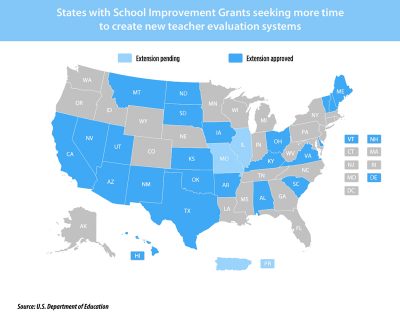What’s the payoff for $3 billion in School Improvement Grants?
The School Improvement Grant (SIG) program, supercharged by a $3 billion windfall under the federal economic-stimulus program in 2009, has jump-started aggressive moves by states and districts. To get their share of the money, they had to quickly identify some of their most academically troubled schools, craft new teacher-evaluation systems, and carve out more time for instruction, among other steps.
Federal teacher evaluation requirement has wide impact
Elliott Elementary in Lincoln, Ne., struck off on its own last year when it became the only school in the city to win money through the federal School Improvement Grant (SIG) program. Winning wasn’t something to be proud of, though: It meant the school qualified as one of the worst in the nation. About a third of fifth-graders at Elliott were proficient on state reading tests when the reforms began, compared to 80 percent in Lincoln as a whole.
Winning also meant a lot of work for teachers and administrators. One of the biggest tasks was overhauling the way teachers at the school are evaluated. Elliott was the only school in the city making the change, which meant it had to come up with a new way of rating teachers mostly on its own.
“The challenge was connecting it to student achievement,” said Jadi Miller, named the principal at Elliott after a longtime principal was ousted to comply with the grant’s mandate of new leadership. “That was certainly very
Winning also meant a lot of work for teachers and administrators. One of the biggest tasks was overhauling the way teachers at the school are evaluated. Elliott was the only school in the city making the change, which meant it had to come up with a new way of rating teachers mostly on its own.
“The challenge was connecting it to student achievement,” said Jadi Miller, named the principal at Elliott after a longtime principal was ousted to comply with the grant’s mandate of new leadership. “That was certainly very
Trying to turn around schools while slashing budgets
For the casual visitor, it’s easy to miss that Southeast High School in rural Kansas—once among the lowest academic performers in the state—is in the midst of a profound transformation.
Like so many other Kansas schools, the building in Cherokee (population: 722) shows the telltale signs of a suffering economy. Bus routes have been cut, as have supplies. Custodians, secretaries and cafeteria workers took an eight-day pay cut. During the harsh winters, students bundle up to make it through classes where the temperature hovers at an uncomfortable, but cost-saving 68 degrees.
Education Week, the Education Writers Association and The Hechinger Report partnered with 18 news outlets in 16 states to investigate how $3 billion in federal School Improvement Grants are being used to revitalize some of the nation’s lowest-performing schools. Interviewing scores of students, teachers, researchers and education
Like so many other Kansas schools, the building in Cherokee (population: 722) shows the telltale signs of a suffering economy. Bus routes have been cut, as have supplies. Custodians, secretaries and cafeteria workers took an eight-day pay cut. During the harsh winters, students bundle up to make it through classes where the temperature hovers at an uncomfortable, but cost-saving 68 degrees.


